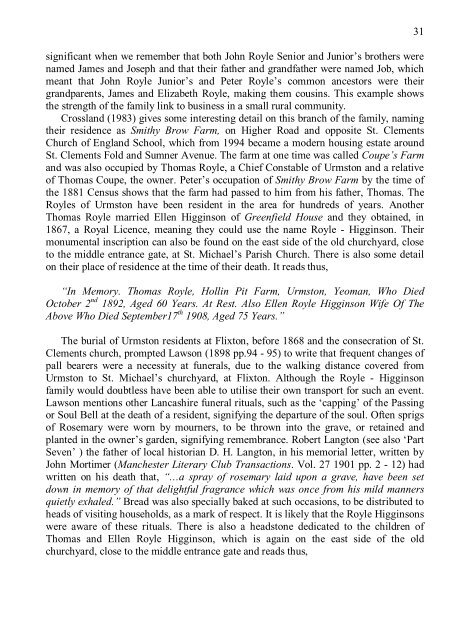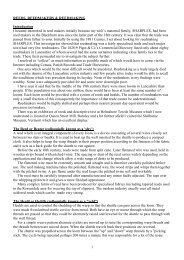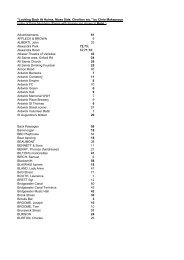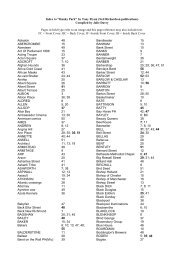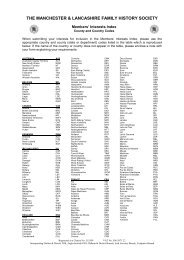The Roles of William and John Henry Royle in the Development of ...
The Roles of William and John Henry Royle in the Development of ...
The Roles of William and John Henry Royle in the Development of ...
You also want an ePaper? Increase the reach of your titles
YUMPU automatically turns print PDFs into web optimized ePapers that Google loves.
significant when we remember that both <strong>John</strong> <strong>Royle</strong> Senior <strong>and</strong> Junior’s bro<strong>the</strong>rs were<br />
named James <strong>and</strong> Joseph <strong>and</strong> that <strong>the</strong>ir fa<strong>the</strong>r <strong>and</strong> gr<strong>and</strong>fa<strong>the</strong>r were named Job, which<br />
meant that <strong>John</strong> <strong>Royle</strong> Junior’s <strong>and</strong> Peter <strong>Royle</strong>’s common ancestors were <strong>the</strong>ir<br />
gr<strong>and</strong>parents, James <strong>and</strong> Elizabeth <strong>Royle</strong>, mak<strong>in</strong>g <strong>the</strong>m cous<strong>in</strong>s. This example shows<br />
<strong>the</strong> strength <strong>of</strong> <strong>the</strong> family l<strong>in</strong>k to bus<strong>in</strong>ess <strong>in</strong> a small rural community.<br />
Crossl<strong>and</strong> (1983) gives some <strong>in</strong>terest<strong>in</strong>g detail on this branch <strong>of</strong> <strong>the</strong> family, nam<strong>in</strong>g<br />
<strong>the</strong>ir residence as Smithy Brow Farm, on Higher Road <strong>and</strong> opposite St. Clements<br />
Church <strong>of</strong> Engl<strong>and</strong> School, which from 1994 became a modern hous<strong>in</strong>g estate around<br />
St. Clements Fold <strong>and</strong> Sumner Avenue. <strong>The</strong> farm at one time was called Coupe’s Farm<br />
<strong>and</strong> was also occupied by Thomas <strong>Royle</strong>, a Chief Constable <strong>of</strong> Urmston <strong>and</strong> a relative<br />
<strong>of</strong> Thomas Coupe, <strong>the</strong> owner. Peter’s occupation <strong>of</strong> Smithy Brow Farm by <strong>the</strong> time <strong>of</strong><br />
<strong>the</strong> 1881 Census shows that <strong>the</strong> farm had passed to him from his fa<strong>the</strong>r, Thomas. <strong>The</strong><br />
<strong>Royle</strong>s <strong>of</strong> Urmston have been resident <strong>in</strong> <strong>the</strong> area for hundreds <strong>of</strong> years. Ano<strong>the</strong>r<br />
Thomas <strong>Royle</strong> married Ellen Higg<strong>in</strong>son <strong>of</strong> Greenfield House <strong>and</strong> <strong>the</strong>y obta<strong>in</strong>ed, <strong>in</strong><br />
1867, a Royal Licence, mean<strong>in</strong>g <strong>the</strong>y could use <strong>the</strong> name <strong>Royle</strong> - Higg<strong>in</strong>son. <strong>The</strong>ir<br />
monumental <strong>in</strong>scription can also be found on <strong>the</strong> east side <strong>of</strong> <strong>the</strong> old churchyard, close<br />
to <strong>the</strong> middle entrance gate, at St. Michael’s Parish Church. <strong>The</strong>re is also some detail<br />
on <strong>the</strong>ir place <strong>of</strong> residence at <strong>the</strong> time <strong>of</strong> <strong>the</strong>ir death. It reads thus,<br />
“In Memory. Thomas <strong>Royle</strong>, Holl<strong>in</strong> Pit Farm, Urmston, Yeoman, Who Died<br />
October 2 nd 1892, Aged 60 Years. At Rest. Also Ellen <strong>Royle</strong> Higg<strong>in</strong>son Wife Of <strong>The</strong><br />
Above Who Died September17 th 1908, Aged 75 Years.”<br />
<strong>The</strong> burial <strong>of</strong> Urmston residents at Flixton, before 1868 <strong>and</strong> <strong>the</strong> consecration <strong>of</strong> St.<br />
Clements church, prompted Lawson (1898 pp.94 - 95) to write that frequent changes <strong>of</strong><br />
pall bearers were a necessity at funerals, due to <strong>the</strong> walk<strong>in</strong>g distance covered from<br />
Urmston to St. Michael’s churchyard, at Flixton. Although <strong>the</strong> <strong>Royle</strong> - Higg<strong>in</strong>son<br />
family would doubtless have been able to utilise <strong>the</strong>ir own transport for such an event.<br />
Lawson mentions o<strong>the</strong>r Lancashire funeral rituals, such as <strong>the</strong> ‘capp<strong>in</strong>g’ <strong>of</strong> <strong>the</strong> Pass<strong>in</strong>g<br />
or Soul Bell at <strong>the</strong> death <strong>of</strong> a resident, signify<strong>in</strong>g <strong>the</strong> departure <strong>of</strong> <strong>the</strong> soul. Often sprigs<br />
<strong>of</strong> Rosemary were worn by mourners, to be thrown <strong>in</strong>to <strong>the</strong> grave, or reta<strong>in</strong>ed <strong>and</strong><br />
planted <strong>in</strong> <strong>the</strong> owner’s garden, signify<strong>in</strong>g remembrance. Robert Langton (see also ‘Part<br />
Seven’ ) <strong>the</strong> fa<strong>the</strong>r <strong>of</strong> local historian D. H. Langton, <strong>in</strong> his memorial letter, written by<br />
<strong>John</strong> Mortimer (Manchester Literary Club Transactions. Vol. 27 1901 pp. 2 - 12) had<br />
written on his death that, “…a spray <strong>of</strong> rosemary laid upon a grave, have been set<br />
down <strong>in</strong> memory <strong>of</strong> that delightful fragrance which was once from his mild manners<br />
quietly exhaled.” Bread was also specially baked at such occasions, to be distributed to<br />
heads <strong>of</strong> visit<strong>in</strong>g households, as a mark <strong>of</strong> respect. It is likely that <strong>the</strong> <strong>Royle</strong> Higg<strong>in</strong>sons<br />
were aware <strong>of</strong> <strong>the</strong>se rituals. <strong>The</strong>re is also a headstone dedicated to <strong>the</strong> children <strong>of</strong><br />
Thomas <strong>and</strong> Ellen <strong>Royle</strong> Higg<strong>in</strong>son, which is aga<strong>in</strong> on <strong>the</strong> east side <strong>of</strong> <strong>the</strong> old<br />
churchyard, close to <strong>the</strong> middle entrance gate <strong>and</strong> reads thus,<br />
31


